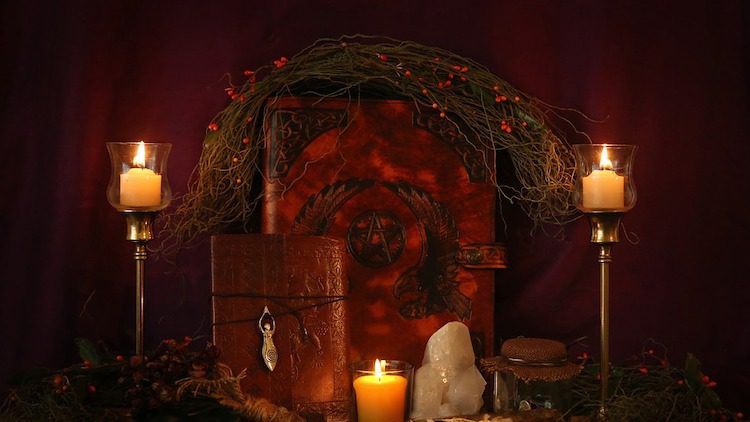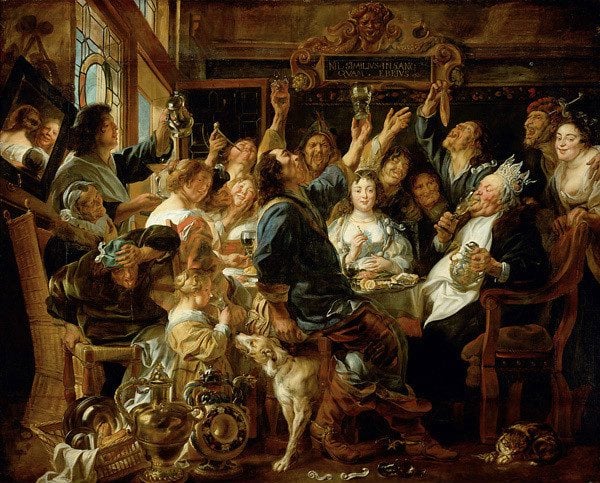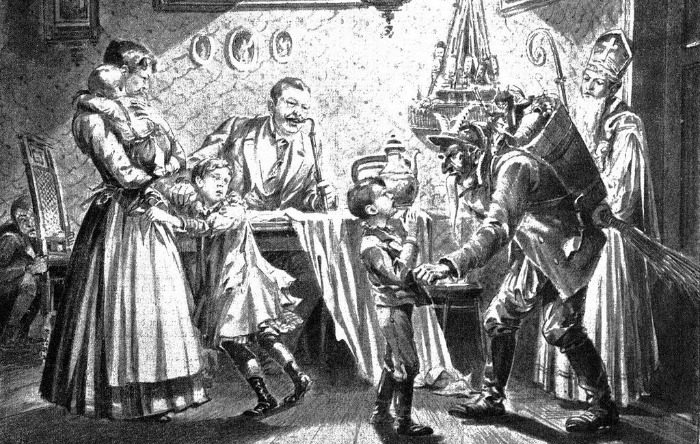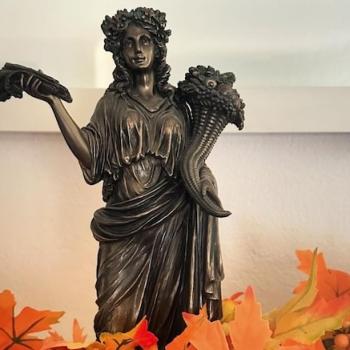Yule is not traditionally one of the “greater sabbats” (a term originally reserved for the cross-quarter holidays), but it’s held a prominent place in Witchcraft since the first Witch went public with their beliefs in the early 1950’s. As early as 1954 in Gerald Gardner’s Witchcraft Today there are references to Yule as an important sabbat, and Gardner even calls it Yule while the rest of the names he uses for the sabbats have fallen out out of favor. As the channel editor of Patheos Pagan I can tell you that December is usually our busiest month in terms of traffic, even beating October most years.
None of these anecdotes prove that Yule is the best sabbat and I’m well aware that there really is no “best sabbat.” We all like what we like, and I sympathize with those of you who are fed up with Christmas Carols, sparkling lights, and the constant thrum of “buy stuff” everywhere. (Hi Misha!) But Yule does have a pretty cool pedigree, and is most certainly popular. I think it’s the best sabbat, and I like to think I make a pretty good argument for it being so.

THE TIES TO PAGAN ANTIQUITY ARE REAL
Labeling things “Christian” or “Pagan” during the Holiday Season is generally more challenging than it looks. The modern Christmas Tree didn’t really arrive until the 14th or 15th Centuries CE, but the use of evergreen branches for decoration in December is a tradition that is literally thousands of years old. One custom most likely begat the other, and in that sense, the Christmas Tree is a mixture of both ancient pagan and Christian design. Other things we associate with Yuletide are more straightforward, holly was first used by pagans as a decoration and then adopted by Christians.
Even more so than the trappings though, Christmas as a celebration can be traced directly to the Roman holidays of Saturnalia and the January Kalends. Customs such as excessive drinking to celebrate the holiday, Lords of Misrule, and charity towards the poor and less fortunate were observed by our pagan ancestors long before being adopted by Christianity. Samhain was most certainly a real holiday celebrated the Irish-Celts, but most of the trappings we associate with it came later. Almost all holidays are a melting pot to some degree, and the stockings hung up by the chimney with care reflect a Christian tradition, but the gift-giver said to fill most of those stockings has very real connections to Odin and depending on the location, most likely other pagan figures of antiquity.
I can’t help but look at “Christmas Decorations” anywhere I go and feel connected to the gods I celebrate and worship. Even things that probably shouldn’t connect me to the gods do anyways. Though the parallels between Jesus and the gods of ancient paganism are often over-stated (though not non-existent), I can’t help but see the Goddess in images of Mary holding Jesus and at least a reflection of other sacrificial gods in nativity scenes. Halloween is full of Witches, but not imagery that evokes the gods of pagan antiquity. What we see at Yuletide just doesn’t happen the rest of the year.

MAGICK IS EMBRACED AT YULE
Witches embrace magick nearly everyday, but society has mostly relegated it to a corner of the room labeled “fantasy,” except in December. If flying reindeer aren’t magickal, I don’t know what is. But the magick is about more than just Santa, his elves, and his draft animals. Yuletide is also home to all sorts of other magickal creatures and figures too, and at least some of them have ties to ancient paganisms. Krampus, Yule Lads, Befana (Christmas Witch ya know!), and Yule Goats are most certainly all magickal.
Perhaps one of the things I love most about the Yule-season is that it teaches people to believe in magick. That starts of course when we are young with the annual gift-giver, but it doesn’t stop there. Magick is expressed in movies like It’s a Wonderful Life and Miracle on 34th Street. The most modern expression of that magick are all of those Hallmark Channel movies that find people overcoming every and all obstacles to find love by Christmas. (Right now, someone you are related to is probably watching one of those movies.) “It’s a Christmas miracle!” is a phrase I hear with a lot of frequency this time of year, and very rarely does it ever involve Jesus.
The most well known Christmas story in the world today isn’t the one about shepherds and the Wise Men, it’s about three ghosts who visit on Christmas Eve. Dickens’ A Christmas Carol is a ghost-story and that’s right there in its full title : A Christmas Carol. In Prose. Being a Ghost Story of Christmas. And ghost stories were once extremely popular around Christmas, and I’m guessing before that near the same time in pagan antiquity, and have only recently have fallen out of favor. It’s easy to understand why too, when it’s only light out for a few hours a day, there’s far more time to wonder what is causing that bump in the night.

CONNECTIONS BEYOND THE COVEN
My wife and I are the only Witches in our extended birth families. This means we celebrate the sabbats almost exclusively with people in our coven, and on certain occasions, with the greater Pagan Community around us. My father has never called to wish me a “Happy Beltane” or a “Merry Mabon,” but we come pretty close to that at Yule. Yes, he signed the card with “Merry Christmas” but the card its self was decorated with holly and presents (another gift from Saturnalia). Besides, he’s not really a practicing Christian anyways. In many ways, Christmas is simply where many of our culture’s winter traditions all got dumped, and we turned it into a legal holiday. (I’ve said it before and I’ll say it again, Christmas can most certainly be a “Christian holiday,” but it doesn’t have to be. In the same way we can all honor every Wednesday as Woden’s Day, but that doesn’t make Wednesday a weekly Pagan holiday.)
I was 28 years old when my grandmother died, which means I practiced Witchcraft the last seven years of her life. It’s hard to find points of contact with people sometimes when the road you are following takes you in a different direction than your loved ones, but I always felt like our roads converged again at Yule. A candlelight Christmas Eve church service is nearly identical to what my coven does at Yule (return of the light!), and most of the decorations are the same too. I loved my family just a little bit more at Christmas, and I find that I do the same now at Yule.
It has become more and more fashionable, especially amongst many Witches, to focus on our differences instead of what we hold in common. I’ve never felt this way. Finding common ground is how we make things better. Decorating a tree or hanging up a wreath with one of my aunts is not quite the same as standing in a magickal circle, but it is a magickal act, and a part of how I celebrate Yule. The Winter Solstice is a holiday I share with those outside of my coven and the Pagan Community, which makes me cherish it all the more.

YULE RITUALS ARE FUN (OR NOT)
I’ve done serious Yule rituals, but I much prefer the ones that tend to be more celebratory in nature. We don’t have to all share wassail together, but wouldn’t it would be nice if we could? There’s something very satisfying about toasting to the health of the coven while feeling your gods near you in circle, extra bonus if everyone is feeling a bit of that holiday magick while we do it!
“Diminished expectations” seems like a shitty reason for Yule being my favorite sabbat, but it’s true. I think people often expect the moon at Beltane and Samhain, and I often feel pressure to deliver it. At Yule most people just want to have some fun, and don’t care how we get there. Joy is reason enough for ritual, and if you need the quiet and the contemplative Yule offers room for that as well.
We all have our favorite holidays, and they are our favorites for a variety of reasons, but to me, Yule stands tall as the greatest one of them all.

















